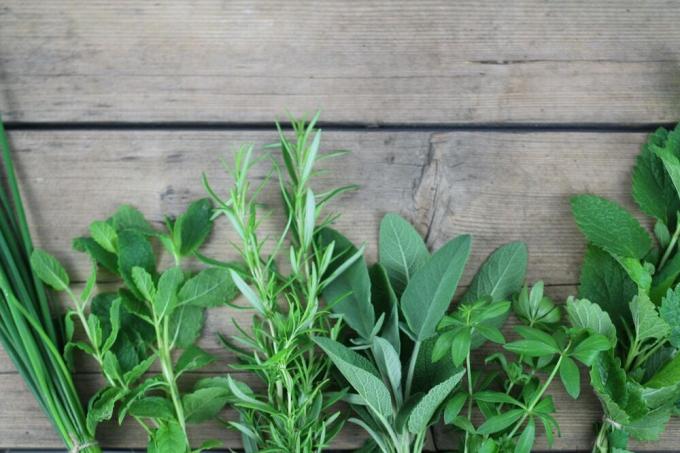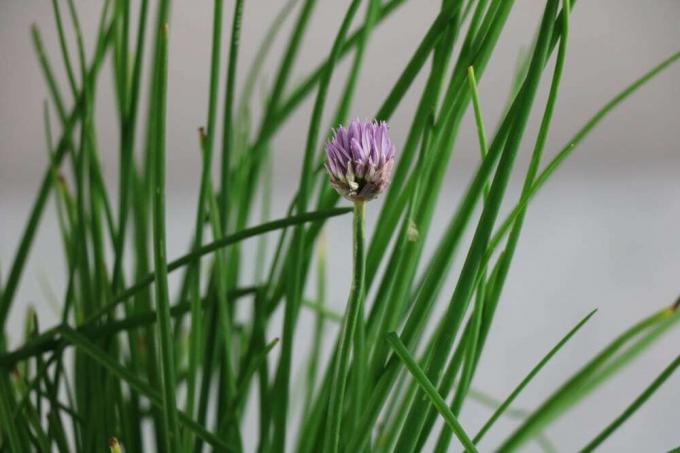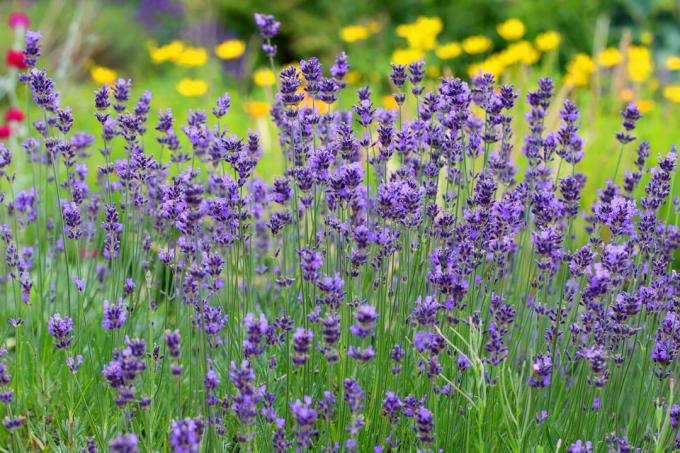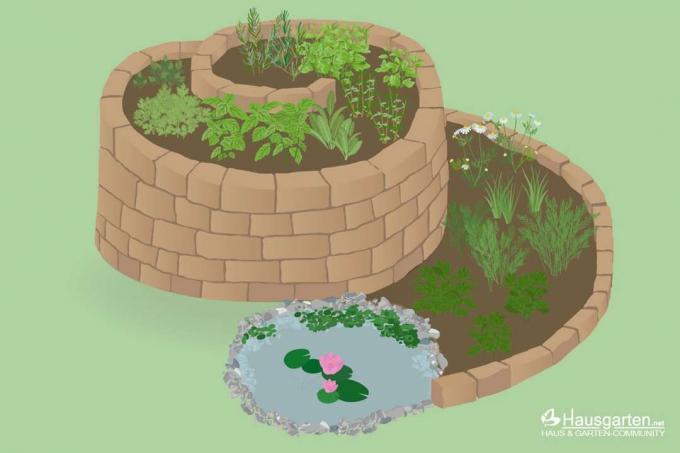

Table of contents
- Herbs for shady locations
- wild garlic
- woman ginseng
- Herbs for partially shaded areas
- peppermint
- chives
- lovage
- Parsely
- Herbs for sunny locations
- basil
- sage
- thyme
- rosemary
- The ideal soil for herbs
- Fertilize herbs properly
- Conclusion
Herbs generally need the ideal location. Otherwise their growth and aroma will suffer. As far as the soil is concerned, half-shady and shady herbs prefer moist soil, while herbs for sunny locations love dry and barren soil. The nutrient requirement also differs from herb to herb. As a rule, the less sunlight, the higher the nutrient requirement. However, over-feeding should be avoided as it stresses these plants and makes them more susceptible to disease.
Herbs for shady locations
wild garlic
Wild garlic grows perennial, persistent and herbaceous with growth heights between 20 and 50 cm. Between March and June it exudes an intense garlic aroma. He is very expansive. Its elongated green leaves appear from February and the star-shaped flowers from April/May to June. In order to prevent unwanted spread, we recommend inserting a plastic film. All parts of the plant can be used.

Tip:
Wild garlic is often confused with autumn crocus or lily of the valley, which can be deadly. Wild garlic is the only one of these plants with a garlic scent. Its leaves sit individually on the stem, while those of the autumn crocus have no petiole and grow into several leaves from one stem. The leaves of the lily of the valley always grow in pairs from a stem.
woman ginseng
Female ginseng, also known as the 'herb of immortality', is an annual to perennial, herbaceous and fast-growing climbing plant for partially shaded and shady locations. She can climb 400-800 cm high. The white, grape-shaped flowers appear between July and August. Its leaves have a liquorice-like taste and can be used to refine salads, be enjoyed on their own or prepared as a tea. Women's ginseng is hardy to -18 degrees.
Herbs for partially shaded areas
peppermint
Peppermint grows persistently, herbaceously and strongly branched. It is hardy, forms runners and grows to a height of 25-100 cm. Cutting back several times a year controls the spread and promotes growth. Peppermint should be transplanted about every 3 years. The fresh or dried leaves and shoots are used.
Tip:
To prevent uncontrolled spread, peppermint can be cultivated in pots or planted in the garden together with the pot.
chives

Chives are one of the classic herbs. It grows persistently and perennial with growth heights between 10 and 50 cm. The numerous breeds differ in growth and taste. In spring it should be divided. The tubular leaves are harvested throughout the season. When flowering begins around May, the aroma is no longer as intense.
lovage
Lovage is perennial, herbaceous and hardy. It has a very aromatic scent and can grow up to 250 cm in optimal conditions. Lovage flowers between July and August and forms so-called double achenes (fruits) after flowering. The plant can be easily propagated by division. The stems and leaves before flowering as well as the seeds and rhizomes are used.
Parsely
Parsley is a versatile herb. There are curly and smooth varieties. The leaves of the herbs, which are between 25 and 80 cm high, are similar to those of celery. Parsley can be cultivated in the garden and in pots and can be harvested all year round. It has a very spicy taste, with flat-leaf parsley having a more intense aroma. The whole plant including the root can be used.
Herbs for sunny locations
basil
Basil needs a warm location. Its numerous cultivated forms differ in leaf colour, aroma, growth and location requirements. It is not hardy and is usually cultivated as an annual. This herbaceous, perennial and upright growing herb reaches heights of 20-60 cm. It blooms between June and September. All parts of the plant smell very aromatic. The taste of the leaves is spicy, sweet to slightly peppery. Fresh or dried leaves and stems are used.
sage
Sage is best known as a herb against sore throats, but also as a spice. It grows as a perennial, perennial subshrub, sometimes annual or biennial, with a height of 40-60 cm and flowers from May to July. The leaves are harvested at the beginning of flowering. Sage smells aromatic and has a spicy, bitter taste. Fresh or dried leaves are used.

Tip:
Sage in pots often forms horny shoots in the winter quarters, which weakens the plant and makes it susceptible to disease. Therefore, you should put them outside during mild winter periods.
thyme
Thyme species grow as perennial subshrubs or shrubs. They become woody at the base, grow upright to decumbent and are mostly hardy. Depending on the species, it grows between 15 and 40 cm high. Flowering time is between May and October. The small leaves smell intensely, their taste is slightly tart and very hearty. The fruits are egg-shaped nutlets containing the seeds. Entire branches are always harvested without cutting down to the woody parts of the plant.
Tip:
The sunnier the location, the higher the content of essential oils, which intensifies the flavor.
rosemary
Characteristic of rosemary are its needle-like leaves. It grows as a bushy, branched, evergreen semi-shrub and can reach heights of 200 cm when old. Scent and aroma are very intense. In winter, protection of the above-ground parts of the plant is necessary, e.g. B. with fleece. Entire branches are used. Annual pruning keeps the shrub compact.
The ideal soil for herbs
The soil requirements of herbs for semi-shady and shady locations differ significantly from those for sunny locations. Partially shaded herbs require moderately moist soil and regular watering. Shady herbs thrive best in permanently moist, humus-rich soil. A high humus content is particularly important here. Mediterranean herbs prefer dry and barren soil and only need to be watered rarely. Regardless of the location, the soil should always be permeable.
Tip:
Clay and loamy soils in particular should be made more permeable with pumice, quartz sand or similar. Soils low in humus can be enriched with compost or manure. Sand can deplete soils.
Fertilize herbs properly
Herbs in sunny locations have a low nutrient requirement. Basic fertilization with compost is sufficient here. In contrast, semi-shady and shady herbs require significantly more nutrients. This is partly due to the lower light yield, which means that fewer nutrients can be dissolved in the soil. Accordingly, the latter should be regularly given organic fertilizers such as horn shavings or manure or a slow-release fertilizer.
A fall foliage cover that decomposes over time can provide nutrients for the following year. For herbs in pots, the amount of fertilizer must be increased slightly.
Conclusion
Herbs find their place in the smallest garden. The location and soil conditions are decisive for an intensive aroma and the best flavor. Herbs not only bring spice and taste to a wide variety of dishes, but can also help against one or the other ailment.
 garden editorial
garden editorial I write about everything that interests me in my garden.
Learn more about growing herbs

Basil has black dots: what to do?
Especially basil bought in a pot from the supermarket tends to quickly develop black dots or spots on the leaves. This article explains why this is and what helps against it.

14 kitchen herbs that you can really keep in the kitchen
Sometimes a herb garden is only possible on the windowsill. If you don't have your own garden bed, for example, or in the months when the frost freezes the coveted greenery outside. Our list provides an overview of which herbs like the kitchen location permanently.

Parsley turns yellow: Four tips against yellow leaves
If the leaves of the parsley suddenly turn yellow, the so-called parsley disease is usually behind it. This can have many causes. If the outbreak of the disease is to be prevented, only prevention helps. More about this here.

You can combine lavender with these 13 plants
Whether you use it in the kitchen, want to enjoy its fragrance or its beauty, lavender is a must in any garden. Well combined, it can strengthen other plants or protect them from pests. We present the best plant neighbors.

8 tips for cutting and harvesting herbs properly
Fresh herbs from the garden should not be missing in any kitchen. They are versatile, exude pleasant and spicy scents and are a treat for the eye with their pretty flowers. In the kitchen, they can easily replace artificial flavor enhancers.

Herb spiral & herb snail: this is how it's done
A herb spiral or herb snail makes it possible to plant many different varieties in a particularly decorative way. However, this is not the only advantage of these variants of the culture. You can find out how to create them here.



